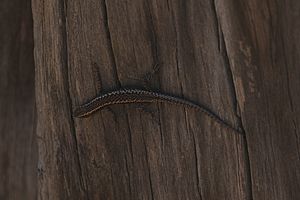Inland snake-eyed skink facts for kids
Quick facts for kids Inland snake-eyed skink |
|
|---|---|
 |
|
| Conservation status | |
| Scientific classification | |
| Genus: |
Cryptoblepharus
|
| Species: |
australis
|
The Cryptoblepharus australis, also known as the inland snake-eyed skink, is a small skink found in Australia. It gets its common name because its eyelids are clear and fused together, making it look like it has "snake eyes."
You say its scientific name like this: KRIP-toe-BLEFF-ah-russ / oss-TRAH-liss.
Contents
What's in a Name?
The name Cryptoblepharus means 'hidden eyelid'. This refers to how its eyelids are joined together, making them seem hidden. The word australis means 'southern' or generally refers to Australia, which is where this skink lives.
Meet the Inland Snake-Eyed Skink
In 2007, a scientist named Paul Horner from the Northern Territory Museum did a big study on these skinks. He found that what was once thought to be one species was actually many different ones, each living in its own special area across Australia.
Paul Horner (2008) also said that Cryptoblepharus skinks are unique to the Northern Territory. Recent studies have shown that the "Top End" of Australia is a very important place for these snake-eyed skinks, with exciting new discoveries for scientists who study reptiles.
How to Spot an Inland Snake-Eyed Skink
Inland snake-eyed skinks usually have some clear features. They have 6 scales above their eyes and 24 rows of scales around the middle of their body. Their scales under their toes are smooth.
These skinks are often greyish in color and have patterns that run along their bodies. Cryptoblepharus skinks are special because they live on vertical surfaces like rocks, trees, and even buildings! To do this, they have a flattened body and long, spread-out limbs and toes. This helps them stay close to the surface and gives them a low center of gravity. These little skinks are super fast and sure-footed, whether they are moving up a wall or across flat ground.
Some skinks that look similar to the inland snake-eyed skink include:
- Metallic snake-eyed skink (Cryptoblepharus metallicus)
- Adams' snake-eyed skink (Cryptoblepharus adamsi)
- Fuhn's snake-eyed skink (Cryptoblepharus fuhni)
- Cryptoblepharus litoralis
- Cryptoblepharus virgatus, also known as the wall skink
Where Do They Live?
The inland snake-eyed skink lives across the dry, central parts of Australia. You can find them stretching north into the Northern Territory and Queensland, east into the central plains of Queensland and New South Wales, and south to the Eyre Peninsula in South Australia. In Western Australia, they are found in the Murchison and Great Victoria Desert areas.
To give you a better idea, they live in the middle of the country, including places like 'Binerah Downs' station, the Yetman area, Armidale, and Wahgunyah State Forest.
Their Home Environment
The Cryptoblepharus australis lives in several types of environments:
- Semi-arid zones (places that are partly dry)
- Woodlands (areas with many trees)
- Open woodlands
- Shrublands (areas with bushes)
- Grasslands
- Spinifex environments (areas with a type of spiky grass)
Daily Habits
These skinks are arboreal, which means they live in trees. They also live on rocks. They are diurnal, meaning they are active during the day. In nature, you can find them hiding under bark on standing trees or in cracks in dead wood and rocks.
Interestingly, snake-eyed skinks can even live on the walls of buildings in busy city centers, like Perth and Cairns! As mentioned before, Cryptoblepharus skinks are great at living on vertical surfaces like rocks, trees, and buildings. These challenging homes require them to have special body features to survive.
What Do They Eat?
The diet of the inland snake-eyed skink is quite simple: they eat insects.
Reproduction and Life Cycle
When it's time to lay eggs, the inland snake-eyed skink usually lays two eggs at a time.
Challenges They Face
Like many other reptiles, inland snake-eyed skinks face several threats:
- Habitat Loss: Their homes are disappearing because land is being cleared for other uses.
- Habitat Damage: Animals like cattle and rabbits can damage the places where skinks live.
- Climate Change: Changes in the world's weather patterns can affect their habitats.
- Roads: Skinks can be hit by cars when crossing roads.
- Predators: Wild animals like dogs, cats, pigs, and foxes hunt them.
- Cane Toads: The introduced cane toad can be a problem for them.
- Diseases: New diseases can also threaten skink populations.


